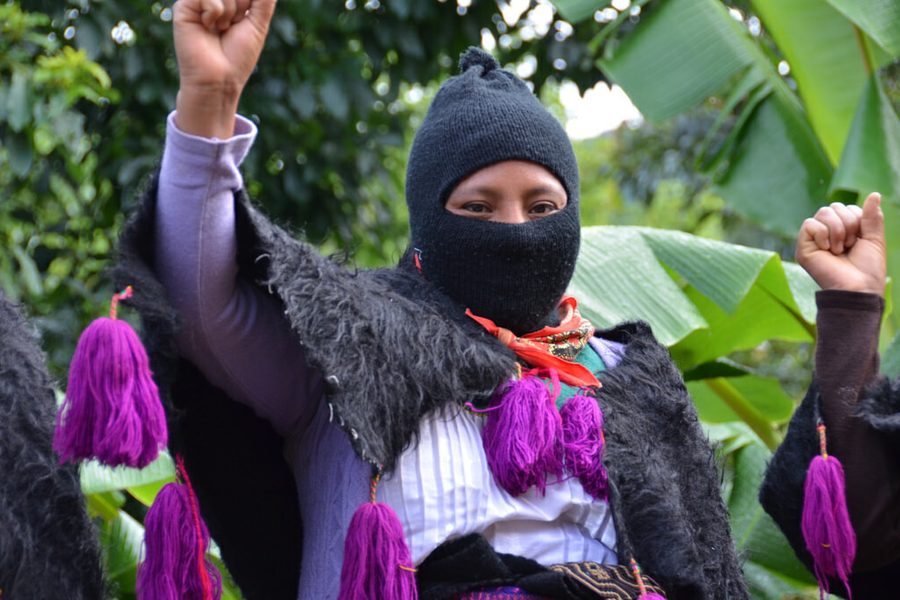The Lessons of Zapatista Women Activists for Today’s Social Movements
The role of indigenous women in the Zapatista movement is little known.
James Tracy

On January 1, 1994, the Zapatista Army of National Liberation (EZLN), made up of mostly indigenous peasants from Mexico’s southern state of Chiapas, declared war on the Mexican government. It was the same day the North American Free Trade Agreement (NAFTA) was signed. Coming three years after the end of the Communist bloc, the Zapatistas offered a unique political perspective that combined indigenous perspectives with an organizing model called “leadership through obedience,” reflecting both anarchist and socialist political traditions. They became one of the major catalysts for the anti-globalization/global justice movement, and the Zapatista ethos offered an alternative to both stale, orthodox leftist party building and the expanding global neoliberal project. Quickly mastering the art of rebellion at the dawn of the internet era, the Zapatistas became a major source of inspiration for young activists, many of whom travelled from North America and Europe to directly work alongside the Zapatistas.
Hilary Klein was one of those young activists. She spent much of the 1990s working in Zapatista communities. Since returning, she has organized at Make the Road New York and currently works the Center For Popular Democracy. Her new book Compañeras: Zapatista Women’s Stories is the first English-language study of the role of indigenous women in the Zapatistas.
Why did you go to live in the Zapatista base communities?
I didn’t go to Mexico intending to live in Zapatista communities. When I went to Chiapas in 1997, I was only planning to stay for about six weeks. I went as a human rights observer — responding to a call from the Zapatistas who were facing consistent attacks from the Mexican armed forces. The presence of outsiders often prevented these attacks and, when they did happen, at least we could document them and get the word out.
But once I got there, I was captivated by the Zapatista movement — the courage, the dignity, the willingness to take risks and the commitment to building something new. And I was particularly struck by women’s role in the movement. There were so many extraordinary women leaders, and Zapatista women had already achieved some pretty remarkable transformations in gender roles. At the same time, these things were still very much evolving. I felt like history was unfolding before my eyes. How could I leave?
So I decided to stay and work with women’s economic cooperatives in Zapatista communities. I ended up being there for six years instead of six weeks.
What about the Zapatistas captured the imagination and attention of radicals in North America and elsewhere?
It’s important to remember the historical context. The Zapatista uprising was in 1994 — at the tail end of the Cold War. After the fall of the Berlin Wall in 1989, capitalists were claiming victory and “the end of history.” Activists and organizers around the world knew that wasn’t the case, but for my generation, it felt like there was a collective question in the air — of what a new wave of liberation movements would look like. The Zapatista movement stepped onto the world stage right at that moment and was one particularly inspiring answer to that question.
Images of the Zapatistas have always been striking — indigenous peasants with wooden rifles declaring war on the Mexican government; with their faces covered by black ski masks or red bandanas, they symbolically became the face of the faceless, the voice of the voiceless. Many people were touched by a movement that was so specific to its own context — peasants in southern Mexico calling for land and indigenous rights, while at the same time being so universal. The Zapatistas presented 11 demands that people all over the world could relate to (work, land, housing, food, health, education, independence, freedom, democracy, justice and peace), and they identified global capitalism as the common enemy — whether you’re a worker, a student or a housewife, young or old, living in the city or in the countryside.
I’m thinking of the Zapatistas’ creation story. The popular narrative was that a group of university-educated revolutionaries from the country’s urban areas went to Chiapas to organize indigenous people, but were transformed and organized in a completely different way by the people of Chiapas. Were there similar dynamics with the internationalists who came to support the Zapatistas?
There’s a lot of truth to that creation story. It’s overly simplified, of course, but the Zapatista movement’s ability to draw from different revolutionary frameworks, to adapt different political and cultural traditions, contributed to it being such a compelling social movement, and so resilient over the years. In terms of the internationalists, it’s much harder to generalize because so many people from so many countries spent time in Chiapas. But it was fascinating to see that relationship evolve over time.
Right after the uprising, the Zapatistas welcomed any type of solidarity. They needed the resources, and they needed the presence of outsiders — internationalists as well as supporters from other parts of Mexico — as protection against the Mexican armed forces. But as the Zapatista project of indigenous autonomy became more and more established (the Zapatistas developed their own local and regional government, health and education infrastructure, and economic structures based on cooperation and solidarity), the EZLN made it increasingly clear that solidarity projects had to respond to the needs identified by Zapatista communities and to respect their leadership.
In the late 1990’s, a number of groups stopped working in Zapatista villages altogether because they weren’t willing to be told what to do by a bunch of indigenous peasants. But others stayed on, and I think developed a much healthier relationship, one based on mutual trust and respect.
Before your book came along, there wasn’t much of an understanding about the role of women in the Zapatista movement. Why was it that so many people’s understanding of zapatismo stopped at Subcomandante Marcos?
Subcomandante Marcos was the spokesperson chosen by the EZLN, and the Zapatistas are very careful about what information they share about themselves. So in some ways it was their own choice that when most outsiders heard about the Zapatista movement, it was through Marcos’s voice. Marcos is a brilliant writer, poetic and articulate, and succeeded in reaching a wide audience. But a cult of personality developed around him that was not particularly helpful. Subcomandante Marcos has stepped back, by the way, and the new Subcomandante is an indigenous man named Moisés.
Information about Zapatista women was available if you were looking for it, but you had to dig past all the stuff about Marcos. And I did think there was a real gap, not only in terms of information, but really in terms of Zapatista women’s voices — that’s one reason I wanted my book to be a vehicle for Zapatista women telling their own stories.
How did your understanding of women in social movements change as a result of writing this book?
I wouldn’t say that my understanding “changed” so much as deepened and evolved. I had the incredible opportunity to witness women’s leadership in the Zapatista movement strengthening over time and to see the interconnected relationship between women’s increased political involvement and changes in so many other areas of life — in the family, in health care, in education. Something that has also really stayed with me are the parallels between women’s involvement in the Zapatista movement and other social movements, in this country and around the world. Very different contexts, of course, different challenges and opportunities, but so many of the same themes come up again and again.
In the United States, feminism is again a subject of intense debate stemming from (to name a few) campus violence, online misogyny and even Hillary Clinton’s run for President. Are there lessons people can draw from your book to deepen this debate?
Definitely. In this country, women’s issues are often framed as a very individual problem. I think one of the most powerful lessons from Zapatista women is that women’s rights and a people’s collective rights are not mutually exclusive. Zapatista women have fought for their rights as women and their rights as indigenous people at the same time. With campus violence, for example, for a long time, cases of sexual assault were treated as isolated incidents. In Zapatista territory, women addressed the problem of domestic violence by working to change an institutionalized culture of violence. They included women’s right to live free of violence in the Women’s Revolutionary Law, they fought for a ban on alcohol in Zapatista communities, and they have carried out ongoing political education and consciousness-raising about violence against women. There might be some interesting lessons here for the women fighting to change the culture of violence on college campuses.
As far as Hillary Clinton’s run for president, I think the main lesson there is that Zapatista women provide an example of what women’s leadership can look like without emulating traditional masculine leadership or the exploitative power dynamics inherent in capitalism.
Do the Zapatistas still matter today?
Absolutely. Even though the Zapatista movement is not in the international spotlight as much as it was 15 or 20 years ago, it’s still alive and well (which is pretty impressive given the counter-insurgency waged against them by the Mexican government for more than two decades).
The Zapatista project of indigenous autonomy still provides a model of local and regional alternatives to global capitalism. The Zapatistas still play an important role supporting and inspiring other social movements.
In Mexico, for example, after 43 students from a rural teachers college in Ayotzinapa were kidnapped and presumed killed in September 2014, a protest movement erupted against the government’s corrupt and violent involvement in the drug war. The EZLN held a series of public events with family members of the 43 disappeared students and other students from Ayotzinapa, many of whom refer to the Zapatista movement as an important reference point for them. And Zapatista women — and their stories of courage and dignity — remind us that revolutionary struggles cannot achieve collective liberation for all people without addressing patriarchy, nor can women’s freedom be disentangled from racial, economic, and social justice.




